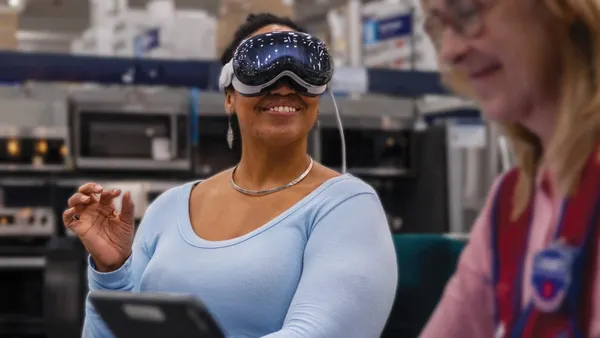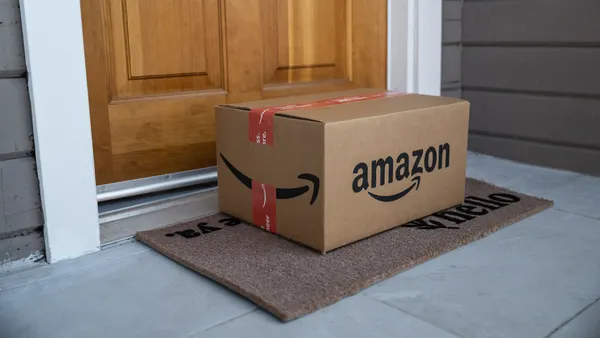Dive Brief:
-
Amazon is bringing together representatives of major consumer goods companies for three days in Seattle to brainstorm packaging and supply chain reforms tailored for the age of e-commerce and ultimately convince them to bypass brick-and-mortar channels and sell directly to the consumer via Amazon Marketplace, Bloomberg reports.
-
"Times are changing," Amazon says in an invitation obtained by Bloomberg. "Amazon strongly believes that supply chains designed to serve the direct-to-consumer business have the power to bring improved customer experiences and global efficiency. To achieve this requires a major shift in thinking.”
-
Wal-Mart, meanwhile, also recently gathered CPG suppliers at its Arkansas headquarters to get tough with them as it renews its commitment to “always low prices,” Recode reports. Wal-Mart told vendors assembled at the summit that it wants to offer the lowest price on 80% of its sales.
Dive Insight:
Consumer goods are a perfect item for Amazon to sell because goods aren’t much differentiated, and even shoppers who have favorite (and even more expensive) brands will seek out retailers offering the best price on them. Moreover, the key advantage that physical retailers have over Amazon — the ability to touch and feel the merchandise — doesn’t matter when it comes to a familiar household product.
That means that for many consumers, loyalty to any one retailer when buying detergent or boxed cereal isn’t quite as strong as to the brand itself, a vulnerability that Amazon is poised to exploit, with promises of fast shipping, same-day delivery in some areas and often low (or at least competitive) prices. There’s already evidence that Amazon’s Prime members in particular use the site to “solve their problem” if their favorite consumer product can’t be found at Target, Wal-Mart or their usual grocery store, according to research from consulting firm Frank N. Magid Associates.
Amazon has already been working hard to capture this market. In 2007 it debuted Subscribe and Save, in 2014 it launched Prime Pantry and in 2015 it unveiled Dash button devices for one-touch reorder of many consumer supplies. Along the way Amazon also has developed private label consumer products, including detergent, diapers and batteries, that give the competition a run for its money.
Amazon additionally has a new sidekick in its efforts — its artificial intelligence-powered voice assistant, Alexa, which remembers what detergent Prime members tend to order, but which fills in the Amazon private label version in a pinch. That might be a point of contention at the meeting described by Bloomberg, according to Magid VP Matt Sargent. “I was surprised there isn’t more of [an outcry] about that,” Sargent told Retail Dive. “If you look at Alexa and how it does ordering — if you haven’t set ‘I always want Tide,’ it’ll make a selection for you. That’s a hugely terrifying proposition for manufacturers.”
Still, Amazon has struggled to make much headway with its consumer goods sales, with just 10% of consumers turning to its site for grocery and household items, compared to more than half (51%) buying consumer electronics and small appliances there, and 25% for health and beauty items, Magid found. Amazon has also grappled with positioning its Prime Pantry program, changing up its pricing structure, and Subscribe and Save customers have found that Amazon’s prices aren’t always consistent or even the best deal.
Wal-Mart’s recent efforts to double down on its “always low prices” commitment are likely putting further pressure on Amazon’s consumer goods game. Although in some cases Amazon’s pricing algorithms swiftly adjust to compete with Wal-Mart and Costco, that doesn’t mean that Amazon’s buyers have managed to get the wholesale pricing that would allow Amazon to protect profits.
Meanwhile, Wal-Mart has a longstanding tradition of playing hardball with its vendors. While conventional wisdom states that Amazon is able to withstand profit pressures thanks to its deep pockets and investor patience, Recode reports that more recently Amazon has been wiling to forgo sales of even popular products, like Pampers diapers, when goods makers don’t cooperate with its pricing schemes. At the same time, the expansion of no-frills grocery chain Aldi and the U.S. debut of its rival Lidl could further fuel a price war and the pressure on both other retailers and consumer goods makers, and Target has also pledged to compete better on price on commodity products like food, consumables and household products.
Of course, consumers will benefit, at least for a time, from what appears to be an emerging price war. But the pricing war and Amazon’s Prime ecosystem present opportunities and challenges for the brands themselves, says omnichannel expert Jenn Markey, VP of Marketing at 360pi.
“For replenishment products where shoppers essentially repeat-purchase, building online channels makes a lot of sense for a brand, especially in the age of 1-hour drone-enabled delivery. Repeat-purchase models also help the brand get and remain entrenched with shoppers, often opting for convenience and loyalty over price,” Markey told Retail Dive in an email. “As they evaluate their online options for growth, brands definitely need to be leery about Amazon’s long-term ambitions. They have seen many of their traditional retail partners be eviscerated by Amazon. Amazon is already pretty clear about their own private label ambitions, especially in electronics. And, as Amazon continues to build its position as the de facto retail channel, just imagine the uneven bargaining position brands could potentially be in. Then, there’s the challenge of counterfeit and grey market goods in online marketplaces, which can negatively impact brand equity and margins. Granted, Amazon is taking active steps to address this problem on their site.”












